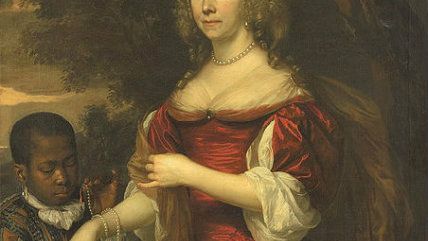Dutch Museum Renames Historic Paintings With More Politically Correct Names
PC hysteria: not just for Americans!


Those concerned about a growing illiberal and ahistorical streak on the American left can take comfort (or pity) in knowing that it's not just us. In Amsterdam, for one, an iconic European art museum has begun renaming historic works whose titles or descriptions might be offensive to modern audiences.
Hence, Simon Maris' early 1900s painting, "Young Negro Girl," has been rechristened "A Young Girl Holding a Fan." A boy described as a "negro servant" in a 1668 portrait of Margaret of Raephorst is now a "young black servant." References to "Eskimos," "Maroons," "Mohammedans," and "Hottentots" will also be removed, with original titles and descriptions preserved in an archive.
According to the U.K.'s Dazed magazine, some 300 works of art at the popular Rijksmuseum have been edited as part of the Adjustment of Colonial Terminology project. "Words such as 'negro,' 'nigger,' and 'Mohammeden' have been replaced with less racially charged terminology in order to avoid causing offense to an increasingly international audience–one that last year was made up of 2.5 million visitors," Dazed reports.
The reasoning behind the changes seems simple enough. It is essentially the same reason we saw a backlash against misplaced cultural appropriation this year, from Valentino and KTZ's "exotic" catwalks to Katy Perry's and Kylie Jenner's cornrows. The reason why, when you turn on the TV this Christmas, the BBC's adaption of Agatha Christie's "Ten Little Niggers" won't be aired under that derogatory, original title. And the reason why you'll no longer find "Tintin in the Congo" in the kids comic section of your high-street book shop. It ultimately comes down to cultural respect.
The curator leading the Rijksmuseum initiative, Martine Gosselink, told the Times that "The point of the project is not to use names given by whites to others." In simple terms she said, "We Dutch are called kaaskops, or cheeseheads, sometimes, and we wouldn't like it if we went to a museum in another country and saw descriptions of images of us as 'kaas kop woman with kaas kop child', and that's exactly the same as what's happening here."
But there's a world of difference between current culture crimes (such as Katy Perry's cornrows) and a painter from the year 1900 using the word "negro." While it may have fallen on the wrong side of linguistic history, negro was not always a derogatory or widely offensive term. Acknowledging that—and perhaps introducing that fact to new generations—doesn't discount the power of language and its propensity to shift with time but rather makes that point more explicit and salient.
Even with terms that have always been derogatory, the mere use of these offensive terms in their original context certainly need not be seen as an endorsement. Instead, it places art works within a particular time and place—a time and place that was very often racist, sexist, nationalistic, and any number of other now-taboo things. These things unwaveringly came to bear on the creation of art at that time period, either consciously or subconsciously, and the curation of art exhibits and museums. Allowing art to remain within such historical contexts is critical to fully understanding both the art and recent history.
"Gauguin's entire oeuvre is western colonialist," noted the Guardian's Stephen Moss, "his depictions of Tahitians exploitative and patronising, but that doesn't mean we ignore him or write off his work. We judge it in its context. Censorship and wrenching art from its original context are barriers to seeing and thinking."
Nonetheless, Rijksmuseum's project has been endorsed by the International Committee of Museums, which holds a lot of pull in the European museum world. Proponents point out that in many cases, artwork descriptions were originally written by curators rather than artists themselves. Other suggest that changing now-offensive words in work titles that weren't "meant to be hate-filled… can actually bring it into line with the original intention rather than distoriting it with words now out of context."
But not everyone is on board. Martin Kemp, a professor of art history at Oxford University, suggested that titles and descriptions not created by the artists themselves should not be sacrosanct, but neither should they automatically be seen as less essential. For example, in a portrait of Saartjie Baartman—a woman brought from South Africa to Britain in the 1800s and exhibited like a zoo animal under the branding "Hottentot Venus"—the now-verboten word Hottentot is essential to understanding the piece itself, he told The Daily Beast. "You have to make clear that [the title] is part of why she was presented and part of the historical rationale for the work."
The director of London's prestigious Tate Modern takes a harder line. He said the Tate would only follow Rijksmuseum's suit when it could get permission from all of the artists in question—a polite way of saying "when hell freezes over," since the majority of them are long dead.



Show Comments (120)